Fox
| Foxes | |
|---|---|

| |
| A red fox in Algonquin Provincial Park, Ontario | |
| Scientific classification | |
| Domain: | Eukaryota |
| Kingdom: | Animalia |
| Phylum: | Chordata |
| Class: | Mammalia |
| Order: | Carnivora |
| Family: | Canidae |
| Subfamily: | Caninae |
| Groups included | |
| |
| Cladistically included but traditionally excluded taxa | |
|
All other species in Canini | |
Foxes are small- to medium-sized
Twelve
Foxes live on every continent except Antarctica. The most common and widespread species of fox is the red fox (Vulpes vulpes) with about 47 recognized subspecies.[2] The global distribution of foxes, together with their widespread reputation for cunning, has contributed to their prominence in popular culture and folklore in many societies around the world. The hunting of foxes with packs of hounds, long an established pursuit in Europe, especially in the British Isles, was exported by European settlers to various parts of the New World.
Etymology
The word fox comes from
Phylogenetic relationships
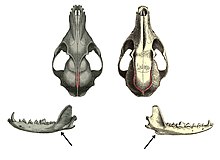
Within the Canidae, the results of DNA analysis shows several phylogenetic divisions:
- The fox-like canids, which include the kit fox (Vulpes velox), red fox (Vulpes vulpes), Cape fox (Vulpes chama), Arctic fox (Vulpes lagopus), and fennec fox (Vulpes zerda).[6]
- The wolf-like canids, (genus Canis, Cuon and Lycaon) including the gray wolf (Canis lupus), red wolf (Canis rufus), eastern wolf (Canis lycaon), coyote (Canis latrans), golden jackal (Canis aureus), Ethiopian wolf (Canis simensis), black-backed jackal (Canis mesomelas), side-striped jackal (Canis adustus), dhole (Cuon alpinus), and African wild dog (Lycaon pictus).[6]
- The South American canids, including the bush dog (Speothos venaticus), hoary fox (Lycalopex uetulus), crab-eating fox (Cerdocyon thous) and maned wolf (Chrysocyon brachyurus).[6]
- Various raccoon dog (Nyctereutes procyonoides).[6]
Biology
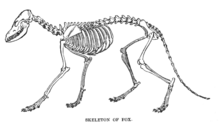
General morphology
Foxes are generally smaller than some other members of the family
Fox features typically include a triangular face, pointed ears, an elongated rostrum, and a bushy tail. They are digitigrade (meaning they walk on their toes). Unlike most members of the family Canidae, foxes have partially retractable claws.[9] Fox vibrissae, or whiskers, are black. The whiskers on the muzzle, known as mystacial vibrissae, average 100–110 millimetres (3+7⁄8–4+3⁄8 inches) long, while the whiskers everywhere else on the head average to be shorter in length. Whiskers (carpal vibrissae) are also on the forelimbs and average 40 mm (1+5⁄8 in) long, pointing downward and backward.[2] Other physical characteristics vary according to habitat and adaptive significance.
Pelage
Fox species differ in fur color, length, and density. Coat colors range from pearly white to black-and-white to black flecked with white or grey on the underside. Fennec foxes (and other species of fox adapted to life in the desert, such as kit foxes), for example, have large ears and short fur to aid in keeping the body cool.[2][9] Arctic foxes, on the other hand, have tiny ears and short limbs as well as thick, insulating fur, which aid in keeping the body warm.[10] Red foxes, by contrast, have a typical auburn pelt, the tail normally ending with a white marking.[11]
A fox's coat color and texture may vary due to the change in seasons; fox pelts are richer and denser in the colder months and lighter in the warmer months. To get rid of the dense winter coat, foxes
Dentition
A fox's dentition, like all other canids, is I 3/3, C 1/1, PM 4/4, M 3/2 = 42. (Bat-eared foxes have six extra molars, totalling in 48 teeth.) Foxes have pronounced carnassial pairs, which is characteristic of a carnivore. These pairs consist of the upper premolar and the lower first molar, and work together to shear tough material like flesh. Foxes' canines are pronounced, also characteristic of a carnivore, and are excellent in gripping prey.[12]
Behaviour
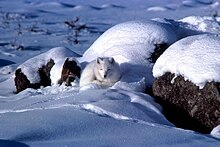
In the wild, the typical lifespan of a fox is one to three years, although individuals may live up to ten years. Unlike many canids, foxes are not always pack animals. Typically, they live in small family groups, but some (such as Arctic foxes) are known to be solitary.[2][9]
Foxes are omnivores.[13][14] Their diet is made up primarily of invertebrates such as insects and small vertebrates such as reptiles and birds. They may also eat eggs and vegetation. Many species are generalist predators, but some (such as the crab-eating fox) have more specialized diets. Most species of fox consume around 1 kg (2.2 lb) of food every day. Foxes cache excess food, burying it for later consumption, usually under leaves, snow, or soil.[9][15] While hunting, foxes tend to use a particular pouncing technique, such that they crouch down to camouflage themselves in the terrain and then use their hind legs to leap up with great force and land on top of their chosen prey.[2] Using their pronounced canine teeth, they can then grip the prey's neck and shake it until it is dead or can be readily disemboweled.[2]
The
Sexual characteristics
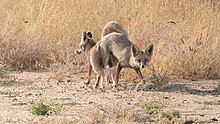
The male fox's
Vixens are in heat for one to six days, making their reproductive cycle twelve months long. As with other canines, the
The vixen usually has six or eight
Vocalization
The fox's vocal repertoire is vast, and includes:
- Whine
- Made shortly after birth. Occurs at a high rate when kits are hungry and when their body temperatures are low. Whining stimulates the mother to care for her young; it also has been known to stimulate the male fox into caring for his mate and kits.
- Yelp
- Made about 19 days later. The kits' whining turns into infantile barks, yelps, which occur heavily during play.
- Explosive call
- At the age of about one month, the kits can emit an explosive call which is intended to be threatening to intruders or other cubs; a high-pitched howl.
- Combative call
- In adults, the explosive call becomes an open-mouthed combative call during any conflict; a sharper bark.
- Growl
- An adult fox's indication to their kits to feed or head to the adult's location.
- Bark
- Adult foxes warn against intruders and in defense by barking.[2][24]
In the case of domesticated foxes, the whining seems to remain in adult individuals as a sign of excitement and submission in the presence of their owners.[2]
Classification
Canids commonly known as foxes include the following genera and species:[2]
| Genus | Species | Picture |
|---|---|---|
| Canis | Ethiopian wolf, sometimes called the Simien fox or Simien jackal |  |
Cerdocyon |
Crab-eating fox | 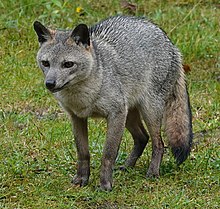 |
| † Dusicyon | Extinct genus, including the Falkland Islands wolf, sometimes known as the Falklands Islands fox | 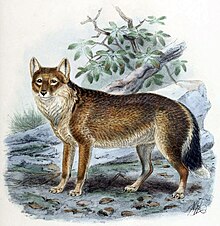 |
Lycalopex |
|
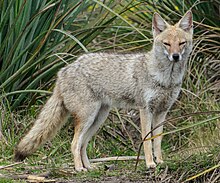 |
Otocyon |
Bat-eared fox | 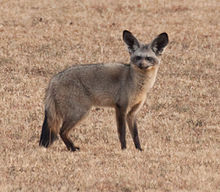 |
| Urocyon |
|
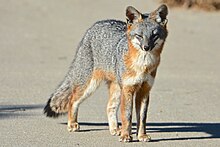 |
| Vulpes |
|
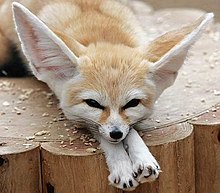 |
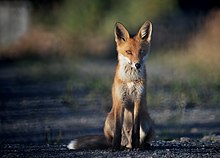
Conservation

Several fox species are
Urocyon littoralis
The
On the California Channel Islands, it was found that the population of the island fox was so low due to an outbreak of
Pseudalopex fulvipes
A major issue the species faces is their dwindling, limited habitat due to the cutting and burning of the unprotected forests.[32] Because of deforestation, the Darwin's fox habitat is shrinking, allowing for their competitor's (chilla fox) preferred habitat of open space, to increase; the Darwin's fox, subsequently, is being outcompeted.[35] Another problem they face is their inability to fight off diseases transmitted by the increasing number of pet dogs.[32] To conserve these animals, researchers suggest the need for the forests that link the Nahuelbuta National Park to the coast of Chile and in turn Chiloé Island and its forests, to be protected.[35] They also suggest that other forests around Chile be examined to determine whether Darwin's foxes have previously existed there or can live there in the future, should the need to reintroduce the species to those areas arise.[35] And finally, the researchers advise for the creation of a captive breeding program, in Chile, because of the limited number of mature individuals in the wild.[35]
Relationships with humans
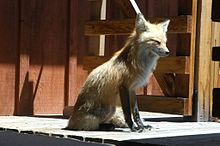
Foxes are often considered pests or nuisance creatures for their opportunistic attacks on poultry and other small livestock. Fox attacks on humans are not common.[36] Many foxes adapt well to human environments, with several species classified as "resident urban carnivores" for their ability to sustain populations entirely within urban boundaries.[37] Foxes in urban areas can live longer and can have smaller litter sizes than foxes in non-urban areas.[37] Urban foxes are ubiquitous in Europe, where they show altered behaviors compared to non-urban foxes, including increased population density, smaller territory, and pack foraging.[38] Foxes have been introduced in numerous locations, with varying effects on indigenous flora and fauna.[39]
In some countries, foxes are major predators of rabbits and hens. Population oscillations of these two species were the first nonlinear oscillation studied and led to the derivation of the
Hunting
Fox hunting originated in the United Kingdom in the 16th century. Hunting with dogs is now banned in the United Kingdom,[42][43][44][45] though hunting without dogs is still permitted. Red foxes were introduced into Australia in the early 19th century for sport, and have since become widespread through much of the country. They have caused population decline among many native species and prey on livestock, especially new lambs.[46] Fox hunting is practiced as recreation in several other countries including Canada, France, Ireland, Italy, Russia, United States and Australia.
Domestication

There are many records of
Urban settings
Foxes are among the comparatively few mammals which have been able to adapt themselves to a certain degree to living in urban (mostly suburban) human environments. Their omnivorous diet allows them to survive on discarded
Urban foxes have been identified as threats to cats and small dogs, and for this reason there is often pressure to exclude them from these environments.[50]
The San Joaquin kit fox is a highly endangered species that has, ironically, become adapted to urban living in the San Joaquin Valley and Salinas Valley of southern California. Its diet includes mice, ground squirrels, rabbits, hares, bird eggs, and insects, and it has claimed habitats in open areas, golf courses, drainage basins, and school grounds.[50]
Though rare, bites by foxes have been reported; in 2018, a woman in Clapham, London was bitten on the arm by a fox after she had left the door to her flat open.[51]
In popular culture

The fox appears in many cultures, usually in
In Asian folklore, foxes are depicted as
The constellation Vulpecula represents a fox.[55]
Notes
- ^ Cf. West Frisian foks, Dutch vos, and German Fuchs.
- Tocharian B päkā 'tail; chowrie', and Lithuanian paustìs 'fur'. The bushy tail forms the basis for the fox's Welsh name, llwynog 'bushy', from llwyn 'bush'. Likewise, Portuguese: raposa from rabo 'tail', Lithuanian uodẽgis from uodegà 'tail', and Ojibwawaagosh from waa, which refers to the up-and-down "bounce" or flickering of an animal or its tail.
References
- ISBN 978-0198515562.
- ^ ISBN 978-0-7134-11904.
- ^ "Episode 113: A Zouthern Accent - The History of English Podcast". historyofenglishpodcast.com. 28 June 2018. Archived from the original on 20 July 2018. Retrieved 20 July 2018.
- ^ Fellows, Dave. "Animal Congregations, or What Do You Call a Group of.....?". Northern Prairie Wildlife Research Center. USGS. Archived from the original on 20 March 2015. Retrieved 9 October 2014.
- ^ "Fox Cubs and the breeding cycle". New Forest Explorers Guide. Archived from the original on 13 August 2016. Retrieved 29 July 2016.
- ^ from the original on 2021-02-24. Retrieved 2017-11-25.
- JSTOR 3504236.
- ISBN 978-0-7614-2237-2.
- ^ ISBN 9780715342176.
- ^ "Arctic fox (Vulpes lagopus)". ARKive. Archived from the original on 2014-10-06. Retrieved 2 October 2014.
- ^ Fox, David. "Vulpes vulpes, red fox". Animal Diversity Web. Archived from the original on 6 October 2014. Retrieved 2 October 2014.
- ^ "Canidae". The University of Edinburgh. Archived from the original on 21 June 2013. Retrieved 23 September 2014.
- S2CID 24289407. Archived from the original(PDF) on 2011-10-06.
- ^ Fox, David L. (2007). "Vulpes vulpes (red fox)". Animal Diversity Web. University of Michigan Museum of Zoology. Archived from the original on 2019-01-06. Retrieved 2009-08-30.
- PMID 1007654.
- ]
- ^ Čanády, Alexander. "Variability of the baculum in the red fox (Vulpes vulpes) from Slovakia." Zoology and Ecology 23.3 (2013): 165–170.
- ^ Bijlsma, Rob G. "Copulatory lock of wild red fox (Vulpes vulpes) in broad daylight. Archived 2017-08-29 at the Wayback Machine" Naturalist 80: 45–67.
- ISBN 978-1886106819.
- ^ Heptner & Naumov 1998, p. 537
- .
- JSTOR 1376014.
- ISBN 978-0-8018-8032-2. Archivedfrom the original on 2023-11-29. Retrieved 2020-10-17.
- S2CID 205107627.
- ^ Ginsburg, Joshua Ross and David Whyte MacDonald. Foxes, Wolves, Jackals, and Dogs Archived 2023-11-30 at the Wayback Machine. p.58.
- ^ Bathgate, Michael. The Fox's Craft in Japanese Religion and Culture Archived 2023-11-29 at the Wayback Machine. 2004. p.18.
- ^ McCandless, Linda Foxes are Beneficial on Fruit Farms. nysaes.cornell.edu (1997-04-24)
- ^ (PDF) from the original on 2016-10-20.
- ^ ISBN 9781605352893.
- ^ .
- ^ a b "Channel Islands: The Restoration of the Island Fox". National Park Service. Archived from the original on 6 October 2014. Retrieved 25 September 2014.
- ^ .
- ^ Silva-Rodríguez, E.; Farias, A.; Moreira-Arce, D.; Cabello, J.; Hidalgo-Hermoso, E.; Lucherini, M. & Jiménez, J. (2016). "Lycalopex fulvipes". IUCN Red List of Threatened Species. 2016: e.T41586A85370871.
- ^ Jiménez, J.E.; Lucherini, M. & Novaro, A.J. (2008). "Pseudalopex fulvipes". IUCN Red List of Threatened Species. 2008. Retrieved 30 September 2014.
- ^ .
- ^ Barratt, Sarah and Martin Barratt. Practical Quail-keeping Archived 2023-11-29 at the Wayback Machine. 2013.
- ^ a b Iossa, G. et al. A Taxonomic Analysis of Urban Carnivore Ecology Archived 2023-11-30 at the Wayback Machine, from Urban Carnivores. Stanley Gehrt et al. eds. 2010. p.174.
- ^ Francis, Robert and Michael Chadwick. Urban Ecosystems Archived 2023-11-29 at the Wayback Machine 2013. p.126.
- ^ See generally Long, John. Introduced Mammals of the World Archived 2023-11-29 at the Wayback Machine. 2013.
- ^ Sprott, Julien. Elegant Chaos Archived 2023-11-29 at the Wayback Machine 2010. p.89.
- ^ Komarova, Natalia. Axiomatic Modeling in Life Sciences Archived 2023-11-29 at the Wayback Machine, from Mathematics and Life Sciences. Alexandra Antoniouk and Roderick Melnik, eds. pp.113–114.
- ^ "Hunt campaigners lose legal bid". BBC News Online. 2006-06-23. Archived from the original on 2008-12-11. Retrieved 2008-11-04.
- ^ Singh, Anita (2009-09-18). "David Cameron 'to vote against fox hunting ban'". The Daily Telegraph. London. Archived from the original on 30 September 2009. Retrieved 2010-05-02.
- ^ Fox Hunting. North West League Against Cruel Sports Support Group. nwlacs.co.uk
- ^ "Fox Hunting: For and Against" (PDF). Archived from the original (PDF) on 2010-03-31. Retrieved 2009-12-12.
- ^ "Fact Sheet: European Red Fox, Department of the Environment, Australian Government". Archived from the original on 2015-12-23. Retrieved 2015-12-23.
- ^ "The most affectionate foxes are bred in Novosibirsk". Redhotrussia. Archived from the original on January 18, 2013. Retrieved 2014-04-08.
- (PDF) from the original on 2003-03-13.
- ISBN 978-0-07-353222-6.
- ^ ISBN 978-1-4665-2127-8. Archivedfrom the original on 29 November 2023. Retrieved 24 September 2018.
- ^ Dunne, John; Moore-Bridger, Benedict; Powell, Tom (2018-06-21). "Woman mauled in bed by fox in Clapham flat: I'm traumatised and feared I would contract rabies". Evening Standard. London. Archived from the original on 2018-06-22. Retrieved 2018-06-22.
- JSTOR 30030396.
- ISBN 978-0-231-13338-8.
- ISBN 9781861892973.
- ^ "Constellation Names". Constellation Guide. Archived from the original on October 6, 2014. Retrieved October 1, 2014.
External links
- BBC Wales Nature: Fox videos
- The fox website
 Texts on Wikisource:
Texts on Wikisource:
- "The American Cyclopædia. 1879.
- "Fox". Encyclopædia Britannica. Vol. 9 (9th ed.). 1879.
- "Cornhill Magazine.
- "New International Encyclopedia. 1905.
- "Fox". Encyclopædia Britannica (11th ed.). 1911.
- "Fox". The New Student's Reference Work. 1914.
- "Fox". Encyclopedia Americana. 1920.
- "Fox". Collier's New Encyclopedia. 1921.
- "
